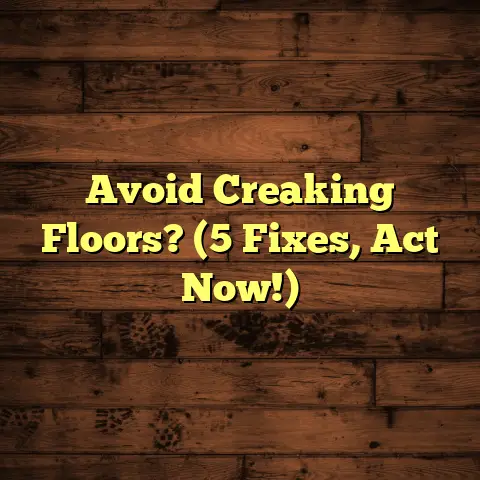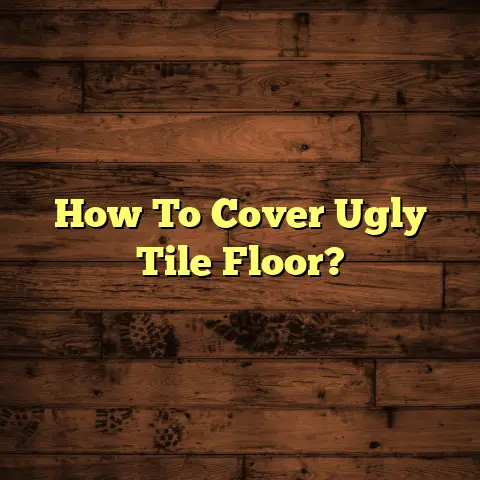Fix Squeaky Floors With Screws? (5 Minute Solution!)
Let’s talk about something that might be bugging you—squeaky floors. I know, it sounds like a minor annoyance, but trust me, it’s more than that.
As a flooring contractor with years of experience, I’ve seen how a squeaky floor can be a sign of underlying issues, and it can even affect your health.
Think about it: your home is your sanctuary. You want it to be a place of peace and relaxation. But what happens when every step you take is accompanied by an irritating squeak? It’s not just annoying; it can actually impact your well-being.
One of the biggest concerns I see is the impact on indoor air quality. Allergens like dust mites, mold spores, and pet dander love to accumulate in homes, especially in areas that aren’t properly maintained.
Squeaky floors often indicate loose floorboards, which create tiny gaps and crevices where these allergens can thrive. According to the American Academy of Allergy, Asthma & Immunology (AAAAI), approximately 50 million Americans suffer from allergies each year.
Imagine those allergens being kicked up into the air every time you walk across that squeaky spot. Not fun, right?
For allergy sufferers, maintaining a clean and quiet home environment is crucial. That means minimizing dust, controlling humidity, and addressing any issues that could contribute to poor air quality.
That’s where the “5-minute solution” comes in: using screws to fix squeaky floors. It’s a simple, effective way to tighten those loose boards, eliminate the noise, and reduce the spaces where allergens can accumulate.
I’m going to walk you through the process step-by-step, so you can tackle this problem yourself and create a healthier, more comfortable living space. Ready to get started?
Section 1: Understanding Squeaky Floors
So, what exactly are squeaky floors, and what causes them? I’ve been asked this question countless times over the years.
Simply put, squeaky floors are floors that make a distinct squeaking sound when you walk on them.
The sound is usually caused by friction between two surfaces rubbing together, most commonly the floorboards and the subfloor.
Let’s break down the mechanics a bit. The main culprit is usually loose floorboards. Over time, the nails or screws that hold the floorboards in place can loosen, allowing the boards to move slightly when you step on them.
This movement creates friction against the subfloor or adjacent boards, resulting in that characteristic squeak.
Temperature and humidity changes also play a role. Wood expands and contracts with changes in moisture levels. This can cause the floorboards to shift and rub against each other, leading to squeaks.
Another factor is the settling of the house. As a house ages, it naturally settles, which can put stress on the flooring and cause boards to loosen.
The type of flooring material also matters. Hardwood floors are particularly prone to squeaking because wood is a natural material that is susceptible to changes in moisture. Laminate floors can also squeak if they are not properly installed or if the subfloor is uneven.
In my experience, squeaky floors are more common in older homes. This is simply because older homes have had more time to settle, and the original nails or screws may have deteriorated.
Think about the emotional and practical implications of dealing with squeaky floors. It’s not just about the noise. It’s about the feeling of unease and the potential embarrassment when you have guests over.
I’ve had clients tell me they avoid certain areas of their homes just to avoid the squeaks. It’s time to put an end to that.
Section 2: The Importance of Addressing Squeaky Floors
Okay, so you’ve got a squeaky floor. What’s the big deal? Can’t you just live with it? Well, technically, yes. But I wouldn’t recommend it.
Ignoring squeaky floors can lead to more serious structural issues over time. If the floorboards are loose, they can continue to move and cause further damage to the subfloor.
This can eventually lead to uneven floors, cracked tiles, or even structural problems in the joists below.
Remember how we talked about allergens? Untreated squeaky floors can become a breeding ground for dust mites, mold, and other allergens.
The gaps between loose floorboards provide the perfect environment for these irritants to accumulate, making your home less healthy.
But it’s not just about the physical problems. There’s also a psychological impact. Living with persistent noises can be incredibly stressful.
It can affect your ability to relax, concentrate, and even sleep. I’ve seen firsthand how much relief homeowners feel after finally addressing their squeaky floors.
I had one client, an elderly woman named Martha, who had been living with a particularly loud squeak in her bedroom for years. She told me it was like living with a constant nagging voice.
After I fixed the floor, she said she finally felt like she could truly relax in her own home.
Another client, a young couple named Sarah and Tom, were constantly embarrassed by the squeaky floors in their living room whenever they had guests over. They felt like their home was never truly presentable.
Fixing the squeaks not only improved the look and feel of their home but also boosted their confidence and social life.
Don’t underestimate the power of a quiet, stable floor. It can make a world of difference in your overall well-being and quality of life.
Section 3: Tools and Materials Needed
Alright, let’s get down to business. Here’s what you’ll need to fix those squeaky floors with screws.
- Screws: This is the most important part. You’ll want to use screws that are specifically designed for wood flooring. I recommend using screws that are long enough to penetrate the floorboard and at least an inch into the joist below. Typically, 2- to 3-inch wood screws should be sufficient.
- Screwdriver or Drill: A standard screwdriver will work, but a drill with a screwdriver bit will make the job much faster and easier. I prefer using a drill with adjustable torque settings to avoid over-tightening the screws.
- Wood Glue (Optional): If you want to add extra stability, you can use a small amount of wood glue between the floorboard and the joist before screwing them together. This will help to prevent future squeaks.
- Measuring Tape: You’ll need a measuring tape to accurately locate the floor joists and determine where to place the screws.
- Stud Finder (If Applicable): If you’re working on a floor that’s covered with carpet or another material that obscures the joists, a stud finder will be essential.
- Safety Goggles and Hearing Protection: Safety first! Always wear safety goggles to protect your eyes from flying debris, and use hearing protection if you’re using a drill.
You can purchase these items at any home improvement store, like Home Depot or Lowe’s. For screws, I recommend brands like GRK Fasteners or Simpson Strong-Tie.
When choosing screws, look for ones that are self-tapping. These screws have a special tip that makes it easier to drive them into the wood without pre-drilling.
Section 4: Step-by-Step Guide to Fixing Squeaky Floors
Okay, it’s time to get your hands dirty. Here’s a step-by-step guide to fixing squeaky floors with screws.
-
Step 1: Identify the Source of the Squeak: This is the most important step. You need to pinpoint exactly where the squeak is coming from. Walk around the room and listen carefully. Have someone else walk around while you observe from different angles.
- Pro Tip: Sometimes, the squeak isn’t directly under your feet. It could be coming from a nearby board that’s connected to the one you’re standing on.
-
Step 2: Prepare the Area: Once you’ve located the squeaky spot, clear any furniture or rugs from the area. Clean the floor thoroughly to remove any dirt or debris. This will help the screws grip better.
-
Step 3: Use a Stud Finder to Locate Joists (If Needed): If you’re working on a floor that’s covered with carpet or another material that obscures the joists, use a stud finder to locate them. The joists are the wooden beams that support the floor. You’ll want to screw the floorboards directly into the joists for maximum stability.
- Pro Tip: If you don’t have a stud finder, you can usually locate the joists by looking for nail patterns in the floor. The nails are usually driven into the joists, so you should be able to see a line of nails running across the floor. Joists are typically spaced 16 inches apart.
-
Step 4: Pre-drill Holes to Prevent Splitting the Wood (When Necessary): If you’re working with hardwood floors, it’s a good idea to pre-drill holes before inserting the screws. This will help to prevent the wood from splitting. Use a drill bit that’s slightly smaller than the diameter of the screws.
- Pro Tip: If you’re not sure whether you need to pre-drill, try inserting a screw without pre-drilling. If the wood starts to split, stop immediately and pre-drill a hole.
-
Step 5: Install Screws into the Floorboards and Joists, Ensuring a Snug Fit: Now it’s time to install the screws. Place the screw over the squeaky spot and drive it into the floorboard and joist below. Use a drill with adjustable torque settings to avoid over-tightening the screws. You want the screw to be snug, but not so tight that it strips the wood.
- Pro Tip: Start with one screw and test the floor to see if the squeak is gone. If not, add another screw nearby. You may need to use several screws to completely eliminate the squeak.
-
Step 6: Test the Floor After Installation to Ensure the Squeak is Gone: Once you’ve installed the screws, walk around the area and listen carefully. If the squeak is gone, congratulations! You’ve successfully fixed your squeaky floor. If not, repeat steps 4 and 5 until the squeak is eliminated.
Section 5: Maintenance Tips
You’ve fixed your squeaky floor. Now, how do you keep it that way? Here are some maintenance tips to prevent future squeaks.
- Regularly Checking for Loose Boards: Make it a habit to inspect your floors regularly for any signs of loose boards. If you notice any movement, tighten the screws or add new ones as needed.
- Keeping Humidity Levels in Check to Prevent Wood Movement: As I mentioned earlier, wood expands and contracts with changes in humidity. Try to keep the humidity levels in your home consistent to minimize wood movement. Use a humidifier or dehumidifier as needed. According to the EPA, indoor humidity should be between 30-50%.
-
Routine Cleaning to Minimize Dust and Allergens: Regular cleaning is essential for maintaining a healthy home environment. Vacuum or sweep your floors regularly to remove dust, dirt, and allergens.
- Pro Tip: Use a vacuum cleaner with a HEPA filter to capture even the smallest particles.
-
Importance of Prompt Repairs as Part of Home Maintenance: Don’t ignore small problems. Address any issues as soon as you notice them to prevent them from becoming bigger, more expensive problems down the road.
By following these maintenance tips, you can keep your floors squeak-free and your home healthy for years to come.
Conclusion
So, there you have it. Fixing squeaky floors with screws is a simple, effective way to improve your home environment.
It’s not just about eliminating an annoying noise. It’s about addressing underlying issues, reducing allergens, and creating a more comfortable living space for yourself and your family.
I know it might seem like a small thing, but trust me, it can make a big difference.
I’ve seen firsthand the positive impact it can have on people’s lives. From reducing stress and improving sleep to boosting confidence and social life, a quiet, stable floor can truly transform your home.
I encourage you to take action and tackle those squeaky floors. It’s a quick fix that can make a world of difference. You deserve to live in a home that’s peaceful, healthy, and free from annoying squeaks.
And remember, if you ever need help with any flooring issues, don’t hesitate to call a professional. We’re here to help you create the home of your dreams.





